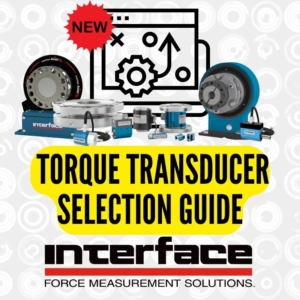New Interface Torque Transducer Selection Guide
 Interface produces content to help our customers in choosing the right force measurement products for their exact application requirements. From our Force Measurement 101 Series to the weekly Interface IQ posts, our focus is in building a repository of support resources that meet the needs of test and measurement professionals across all types of industries.
Interface produces content to help our customers in choosing the right force measurement products for their exact application requirements. From our Force Measurement 101 Series to the weekly Interface IQ posts, our focus is in building a repository of support resources that meet the needs of test and measurement professionals across all types of industries.
Our new Interface Torque Transducer Selection Guide helps to quickly evaluate the range of Interface’s torque transducer models based on whether you need a reaction (static) or rotary (dynamic) style. The guide assists in selecting best torque sensor based on features and capabilities, such as bearingless, contactless, compact, miniature, force and torque, overload protected, wireless, and USB output options.
Interface’s new web resource covers several types of torque sensors including flange mount, shaft type, square drive, hex drive, and couplings. If you’ve read our blog Choosing the Right Torque Transducer, which would also be a good place to start, you will understand how important it is to choose the right product, options and accessories for the job.
A torque sensor selection guide is typically used by engineers or technicians who need to choose a torque sensor for a specific application. Here are four easy steps to follow when using the Interface Torque Transducer Selection Guide:
- Determine the requirements of your application: Before selecting a torque sensor, you need to understand the specific requirements of your application. This includes the torque range you need to measure, the type of torque reaction versus rotary, shaft or mounting of the components you will be measuring, the environment in which the sensor will be used, and any other relevant factors related to the type of device you choose.
- Choose the type of torque sensor: There are several types of torque sensors available, including reaction or rotary, shaft or flange, shaft style, floating or fixed, and bearings or bearingless. The selection guide provides information about the features of each type, so you can choose the one that is best suited for your use case.
- Consider the accuracy and resolution: These both are key factors to consider, especially if you need to make precise measurements. The selection torque guide helps deliver specification details for each torque sensor, so you can choose the one that meets your requirements.
- Evaluate the physical characteristics: The physical characteristics of the torque transducer includes the size and shape of the sensor, the mounting options, and any distinctive features such as temperature compensation or overload protection.
By following these steps and using the information provided in the Interface Torque Transducer Selection Guide, it is easier to choose a sensor that is well-suited for your application and provides accurate and reliable measurements you require.
The Interface Torque Transducer Selection Guide helps to define the right product, as well as provide supplemental help and answers to frequently asked questions, including:
- What is a torque transducer?
- Reaction versus Rotary?
- Shaft versus Flange?
- Floating versus Fixed?
- Bearings versus Bearingless?
- Dual Range
- RPM Considerations
- Accuracy and Resolution
- Coupling Types
Unsure of where to start? Check out Torque Transducers 101 or Recap of New Twist on Torque including the complete webinar below. In addition to our standard products, Interface has a custom solutions group that can collaborate with you to customize torque transducers, instrumentation, and complete measurement systems to fit your exact needs. Contact Interface’s torque expert application engineers if you need assistance or require a quote.
ADDITIONAL RESOURCES
Miniature Torque Transducers 101
Choosing the Right Torque Transducer
A Comparison of Torque Measurement Systems White Paper
Aircraft Yoke Torque Measurement
Fuel Pump Optimization & Rotary Torque
CPG Dental Handpiece Torque Check
Torque-Transducer-Brochure







